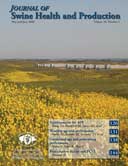Abstract:

Effect of weaning age on nursery pig and sow reproductive performance
Alison L. Smith, MSc; Kenneth J. Stalder, MSc, PhD; Timo V. Serenius, MSc, PhD; Tom J. Baas, MSc, PhD; John W. Mabry, MSc, PhD
Complete article is available online.
PDF version is available online.
Objectives: To determine the effect of weaning age on nursery-pig and sow reproductive performance.
Materials and methods: A total of 2467 crossbred barrows and gilts from 339 litters produced in a commercial multiplication herd were randomly allocated to pens by weaning age. Average weaning-age treatments were 15 days (14, 15, and 16 days) and 20 days (19, 20, and 21 days). To evaluate the effect of weaning age on nursery-pig performance, average daily gain (ADG), average daily feed intake (ADFI), gain:feed ratio, and feed cost per kg gain were evaluated. Subsequent sow reproductive performance evaluated included wean-to-first-service interval (WSI), wean-to-conception interval, total number of piglets born, and total live-born piglets.
Results: Mean 42-day weight was greater (21.8 ± 0.16 versus 18.7 ± 0.11 kg; P < .001), nursery ADG was greater (0.79 ± .01 versus 0.71 ± 0.04 kg per day; P < .01), ADFI was greater (0.64 ± 0.01 versus 0.57 ± 0.01 kg per day; P < .001), and 1.06 % fewer pigs were removed from test (P < .05) in pigs weaned at average 20 days of age than in pigs weaned at average 15 days of age. Sow reproductive traits did not differ between the two weaning-age treatment groups. Parity was a significant source of variation for WSI and total live-born piglets.
Implications: Weaning age between 15 and 20 days may have no effect on sow reproductive traits, but may significantly impact nursery growth rate.
Keywords: weaning age, sows, wean-to-first-service interval
![]() Cite as: Smith AL, Stalder KJ, Serenius TV, et al. Effect of weaning age on nursery pig and sow reproductive performance. J Swine Health Prod 2008;16(3):131-137.
Cite as: Smith AL, Stalder KJ, Serenius TV, et al. Effect of weaning age on nursery pig and sow reproductive performance. J Swine Health Prod 2008;16(3):131-137.
Search the AASV web site for pages with similar keywords.
